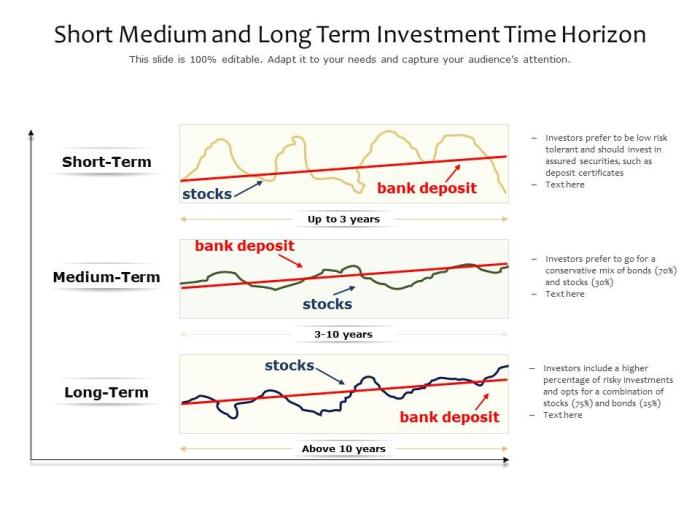
Embark on a journey into the world of Long-Term Investment Horizon Best Practices, where financial success is within reach through strategic planning and insightful decision-making.
Delve into the key principles and strategies that can help investors navigate market volatility and achieve long-term growth.
Importance of Long-Term Investment Horizon
Having a long-term investment horizon is crucial for financial success as it allows investors to benefit from the power of compounding over time. By staying invested for the long haul, investors can weather short-term market fluctuations and achieve significant growth in their portfolios.
Riding Out Market Volatility
A long-term perspective helps investors ride out market volatility by focusing on the overall trend of the market rather than short-term fluctuations. Instead of reacting impulsively to market ups and downs, long-term investors stay committed to their investment strategy, knowing that over time, the market tends to trend upwards.
- Long-term investors can take advantage of buying opportunities during market downturns, as they have the patience to wait for the market to recover.
- They can also avoid the emotional pitfalls of market volatility by staying disciplined and sticking to their long-term investment plan.
- By staying invested for the long term, investors can benefit from the power of compounding, where their returns generate further returns over time.
Successful Investors Benefiting from Long-Term Approach
Many successful investors have attributed their success to maintaining a long-term investment horizon. Warren Buffett, known as one of the greatest investors of all time, has famously said, “Our favorite holding period is forever,” emphasizing the value of long-term investing.
“The stock market is designed to transfer money from the Active to the Patient.”
Warren Buffett
Other successful investors like Peter Lynch and John Bogle have also advocated for a long-term approach to investing, highlighting the importance of patience, discipline, and a focus on fundamentals rather than short-term market noise.
Best Practices for Long-Term Investment Strategies
Developing a successful long-term investment strategy requires adherence to key principles that can help investors navigate the complexities of the financial markets and achieve their investment goals.
Significance of Diversification
Diversification is a crucial element of a long-term investment portfolio as it helps reduce risk by spreading investments across different asset classes, industries, and regions. By diversifying your portfolio, you can minimize the impact of market volatility on your overall returns. Remember the old adage, “Don’t put all your eggs in one basket.”
Role of Risk Management
Risk management plays a critical role in long-term investment planning as it involves identifying, assessing, and mitigating potential risks that could impact your investment performance. By implementing risk management strategies such as setting stop-loss orders, using asset allocation techniques, and conducting regular portfolio reviews, investors can protect their capital and optimize returns over the long term.
Investment Horizon and Risk Assessment

When planning for a long-term investment horizon, it is crucial to assess risk tolerance to ensure that your investment strategy aligns with your financial goals and objectives. Risk assessment helps investors determine the level of risk they are willing to take on in exchange for potential returns over a long period of time.
Assessing Risk Tolerance
- Consider your financial goals: Determine your long-term financial goals and how much risk you are willing to take to achieve them.
- Evaluate your investment timeline: Longer investment horizons generally allow for a higher risk tolerance as there is more time to recover from any market downturns.
- Understand your emotions: Be honest with yourself about how you would react to market fluctuations and volatility.
Comparison of Risk Assessment Tools
- Standard Deviation: Measures the volatility of an investment’s returns over a specific period of time.
- Beta Coefficient: Indicates how sensitive an investment is to market movements.
- Sharpe Ratio: Evaluates the risk-adjusted return of an investment.
Adjusting Investment Strategies Based on Risk Assessments
- Diversification: Spread your investments across different asset classes to reduce risk.
- Rebalancing: Regularly review and adjust your portfolio to maintain the desired level of risk exposure.
- Monitoring: Keep track of your investments and make changes as needed based on your risk tolerance and long-term goals.
Investment Opportunities for Long-Term Growth
Investing for the long term requires careful consideration of opportunities that can provide sustainable growth over time. By focusing on industries or sectors with strong growth potential, investors can position themselves for success in the long run.
Technology Sector
The technology sector has been a consistent performer in terms of long-term growth. Companies in this sector are often at the forefront of innovation and are well-positioned to capitalize on changing consumer trends. Investing in tech giants like Apple, Microsoft, or Amazon can offer significant growth potential over the years.
- Companies in the tech sector are known for their ability to adapt to changing market conditions and drive innovation.
- Technological advancements continue to shape the way we live and work, making this sector a promising option for long-term investors.
- Investing in technology ETFs or mutual funds can provide exposure to a diversified portfolio of tech stocks, reducing individual company risk.
Healthcare Industry
The healthcare industry is another sector that offers attractive opportunities for long-term growth. With an aging population and increasing focus on healthcare services, companies in this sector have the potential for sustained growth. Investing in healthcare companies involved in pharmaceuticals, medical devices, or healthcare services can be a strategic move for long-term investors.
- The demand for healthcare services is expected to continue growing as populations age, providing a stable revenue stream for healthcare companies.
- Investing in healthcare ETFs or mutual funds can provide exposure to a diverse range of healthcare companies, spreading risk across the sector.
- Biotechnology companies, in particular, offer high growth potential but come with increased volatility, making them suitable for investors with a higher risk tolerance.
Renewable Energy Sector
As the world shifts towards sustainable energy sources, the renewable energy sector presents exciting investment opportunities for long-term growth. Companies involved in solar, wind, or other renewable energy sources are well-positioned to benefit from the global push towards clean energy. Investing in renewable energy companies or funds can offer both financial returns and environmental impact.
- Government support and increasing awareness of climate change are driving growth in the renewable energy sector, making it a lucrative investment option.
- Renewable energy companies often have stable cash flows and long-term growth potential, making them attractive to long-term investors.
- Investing in renewable energy ETFs or mutual funds can provide exposure to a diversified portfolio of companies in the sector, reducing risk and enhancing potential returns.
Role of Investment Advisors in Long-Term Planning

Investment advisors play a crucial role in helping individuals and organizations make informed decisions about their long-term financial goals. Their expertise and guidance can significantly impact the success of a long-term investment strategy.
Qualifications and Expertise of Investment Advisors
When choosing an investment advisor for long-term planning, it is essential to look for certain qualifications and expertise. These may include:
- Professional certifications such as CFA (Chartered Financial Analyst) or CFP (Certified Financial Planner)
- Experience in managing long-term investment portfolios
- A solid track record of success in helping clients achieve their financial goals
- Strong knowledge of various investment vehicles and strategies
Effective Communication with Investment Advisors
To ensure effective communication with your investment advisor for long-term goals, consider the following tips:
- Clearly articulate your financial objectives and risk tolerance
- Regularly review and discuss your investment portfolio performance
- Stay informed about market trends and economic factors that may impact your investments
- Ask questions and seek clarification on any investment recommendations
Investment Banking and Long-Term Investment Strategies
Investment banks play a crucial role in facilitating long-term investment opportunities by providing a range of financial services to individuals and institutions. These services include underwriting securities, providing advisory services, and facilitating mergers and acquisitions.
Role of Investment Banks in Long-Term Capital Allocation
Investment banks can help individuals or institutions with long-term capital allocation by offering expertise in structuring investment portfolios, accessing capital markets, and identifying suitable investment opportunities. They help clients navigate complex financial markets and make informed decisions that align with their long-term financial goals.
- Investment banks assist in raising capital for long-term projects by underwriting debt and equity securities, ensuring that companies have access to the funds they need to support growth initiatives.
- They provide strategic advice on mergers, acquisitions, and divestitures, helping clients identify opportunities for expansion or restructuring that can drive long-term value creation.
- Investment banks also offer research and analysis on market trends, industry dynamics, and investment opportunities, enabling clients to make informed decisions based on comprehensive market insights.
Examples of Successful Collaborations between Investors and Investment Banks
Investors and investment banks often collaborate on long-term investment strategies to achieve sustainable growth and maximize returns. Some successful collaborations include:
- Joint ventures between institutional investors and investment banks to finance infrastructure projects that generate long-term revenues and contribute to economic development.
- Strategic partnerships between high-net-worth individuals and investment banks to structure diversified investment portfolios that balance risk and return over the long term.
- Collaborations between corporate clients and investment banks to execute capital raising initiatives, such as initial public offerings (IPOs) or bond issuances, to support long-term expansion plans.
In conclusion, mastering Long-Term Investment Horizon Best Practices is the key to securing a stable financial future and realizing your investment goals with confidence.
Clarifying Questions
How important is a long-term investment horizon?
A long-term investment horizon is crucial for financial success as it allows investors to ride out market volatility and benefit from compounding returns over time.
What are some key principles for developing a successful long-term investment strategy?
Key principles include diversification, risk management, and aligning investments with long-term goals.
How can risk assessment tools help in long-term investments?
Risk assessment tools aid in evaluating risk tolerance, adjusting investment strategies, and making informed decisions for long-term growth.
Why is seeking advice from investment advisors important for long-term planning?
Investment advisors provide expertise in financial planning, offer guidance on investment opportunities, and help align strategies with long-term goals.
What role do investment banks play in long-term investment strategies?
Investment banks facilitate long-term investment opportunities, assist with capital allocation, and foster collaborations for sustained growth.






